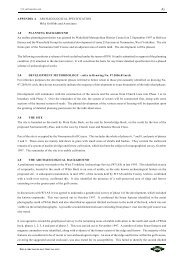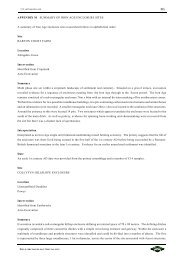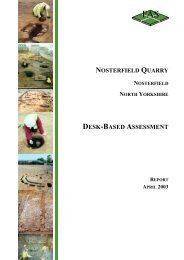ARCHAEOLOGICAL EVALUATION - Mike Griffiths and Associates
ARCHAEOLOGICAL EVALUATION - Mike Griffiths and Associates
ARCHAEOLOGICAL EVALUATION - Mike Griffiths and Associates
Create successful ePaper yourself
Turn your PDF publications into a flip-book with our unique Google optimized e-Paper software.
FAS_lbf01.wpd 124<br />
75). The stratigraphically earliest fill to be encountered, C1217, consisted of a tipping deposit of grey clean<br />
sterile silt <strong>and</strong> proved to be homogenous <strong>and</strong> contained only gravel. C1217 was visible in both the east <strong>and</strong> west<br />
facing sections of F30, <strong>and</strong> was very similar to a b<strong>and</strong> of gravelly coarse s<strong>and</strong> in the surrounding natural system<br />
at the same height as C1217. C1217 was overlain by a deposit of sterile gravel which contained black-coloured<br />
flecks which were thought to be manganese mineralisation (C1220). C1220 was overlain by a desiccated poorquality<br />
blocky peat with occasional veins of silver s<strong>and</strong> <strong>and</strong> mixed gravel throughout (C1219), which appeared<br />
to be tipping or ‘u’-shaped in profile. This deposit was overlain in turn by C1218 a tip of clean grey silt with<br />
rare charcoal flecks (2%), which was only visible in the north facing section of the feature. C1218 was overlain<br />
by another deposit with a tipping profile, C1216, which was a gravel-rich grey coarse s<strong>and</strong>. C1216 was defined<br />
as a clean sterile grey silt with rare mixed gravel inclusions measuring 0.50m thick within the excavated sample,<br />
although its full depth is unknown. This deposit was sealed by a ‘u’-shaped deposit of clean brown gravel-rich<br />
silt measuring up to c.1.00m in depth, which represented the latest fill of the feature (C1211).<br />
The fill system of F30 consisted mainly of tipping deposits, at least one of which represented the slumping of<br />
the surrounding natural subsoil (C1217), <strong>and</strong> only one of which consisted of desiccated peat (C1219); F30 was<br />
consequently interpreted as a sink hole <strong>and</strong> corresponded with the position of F24 (Intervention 4).<br />
8.2.22 Intervention 28<br />
Intervention 28 was situated 28.80m from the northern<br />
boundary of Zone D within Zone B (see Figure 36). This<br />
machine-excavated trench measured 50m x 4m <strong>and</strong> was<br />
orientated east-west (Plate 32). Ground surface sloped down<br />
from c.41.15m AOD at the western end of the trench to<br />
c.40.55m AOD at the eastern end. The dark yellowish-brown<br />
ploughsoil (C1123) was found to be c.0.40m in depth<br />
throughout the trench <strong>and</strong> overlay an orangish-brown gravel <strong>and</strong><br />
clayey silt subsoil (C1124) which became more grey <strong>and</strong> silty<br />
towards the eastern end of the trench.<br />
Plate 32 Intervention 28 looking east (scale<br />
2m)<br />
A single feature, F32 was identified within Intervention 28 <strong>and</strong> was situated against the southern edge of the<br />
trench <strong>and</strong> continued beyond it (Figure 76). It appeared as a possibly circular deposit of dark olive grey s<strong>and</strong>y<br />
clay measuring c.0.70m in diameter. The entire available area was excavated <strong>and</strong> the feature proved to be a<br />
shallow, possibly sub-rectangular cut with steep sides <strong>and</strong> a flat base (Figure 77). Definition of the feature’s<br />
edges against C1124 was problematic, but two deposits were identified during excavation, C1214 <strong>and</strong> C1215.<br />
C1215 was the earliest backfill <strong>and</strong> consisted of a mixed olive grey friable clayey s<strong>and</strong> with lenses of friable<br />
yellow s<strong>and</strong> throughout. Occasional mixed gravel <strong>and</strong> pebbles were noted, but the deposit was otherwise sterile.<br />
C1215 was overlain by C1214, a dark olive grey s<strong>and</strong>y clay which contained charcoal flecks <strong>and</strong> very rare (2%)<br />
fine mixed gravel. F32 was interpreted as a small pit; no dateable material was recovered during excavation.<br />
8.2.23 Intervention 29<br />
Intervention 29 was situated towards the northern boundary of Zone B (see Figure 36). The machine-excavated<br />
FIELD ARCHAEOLOGY SPECIALISTS







